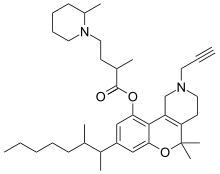Menabitan
Menabitan (INN; SP-204), or menabitan hydrochloride (USAN), is a synthetic drug which acts as a potent cannabinoid receptor agonist.[1][2] It is closely related to natural cannabinoids of the tetrahydrocannabinol (THC) group, differing mainly by its longer and branched side chain, and the replacement of the 9-position carbon with a nitrogen.[1] It was studied as an analgesic in the 1970s and was found to possess antinociceptive effects in both humans and animals but was never marketed.[1][3][4]
 | |
| Clinical data | |
|---|---|
| ATC code |
|
| Legal status | |
| Legal status |
|
| Identifiers | |
IUPAC name
| |
| CAS Number |
|
| PubChem CID | |
| ChemSpider | |
| Chemical and physical data | |
| Formula | C37H56N2O3 |
| Molar mass | 576.85214 g/mol g·mol−1 |
| 3D model (JSmol) | |
SMILES
| |
InChI
| |
Due to its structural similarity to the schedule I/III drug THC it can be treated as a schedule I drug within the United States legal system under the Federal Analogue Act.
See also
- A-40174 (SP-1)
- Dimethylheptylpyran
References
- Green K, Kim K (February 1977). "Acute dose response of intraocular pressure to topical and oral cannabinoids". Proceedings of the Society for Experimental Biology and Medicine. Society for Experimental Biology and Medicine (New York, N.Y.). 154 (2): 228–31. doi:10.3181/00379727-154-39643. PMID 402656.
- David J. Triggle (1996). Dictionary of Pharmacological Agents. Boca Raton: Chapman & Hall/CRC. p. 1271. ISBN 978-0-412-46630-4.
- Reggio PH (1987). "Molecular determinants for cannabinoid activity: refinement of a molecular reactivity template". NIDA Research Monograph. 79: 82–95. PMID 2830539.
- Gabriel G. Nahas (5 April 1999). Marihuana and Medicine. Humana Press. p. 46. ISBN 978-0-89603-593-5. Retrieved 9 May 2012.
This article is issued from
Wikipedia.
The text is licensed under Creative
Commons - Attribution - Sharealike.
Additional terms may apply for the media files.